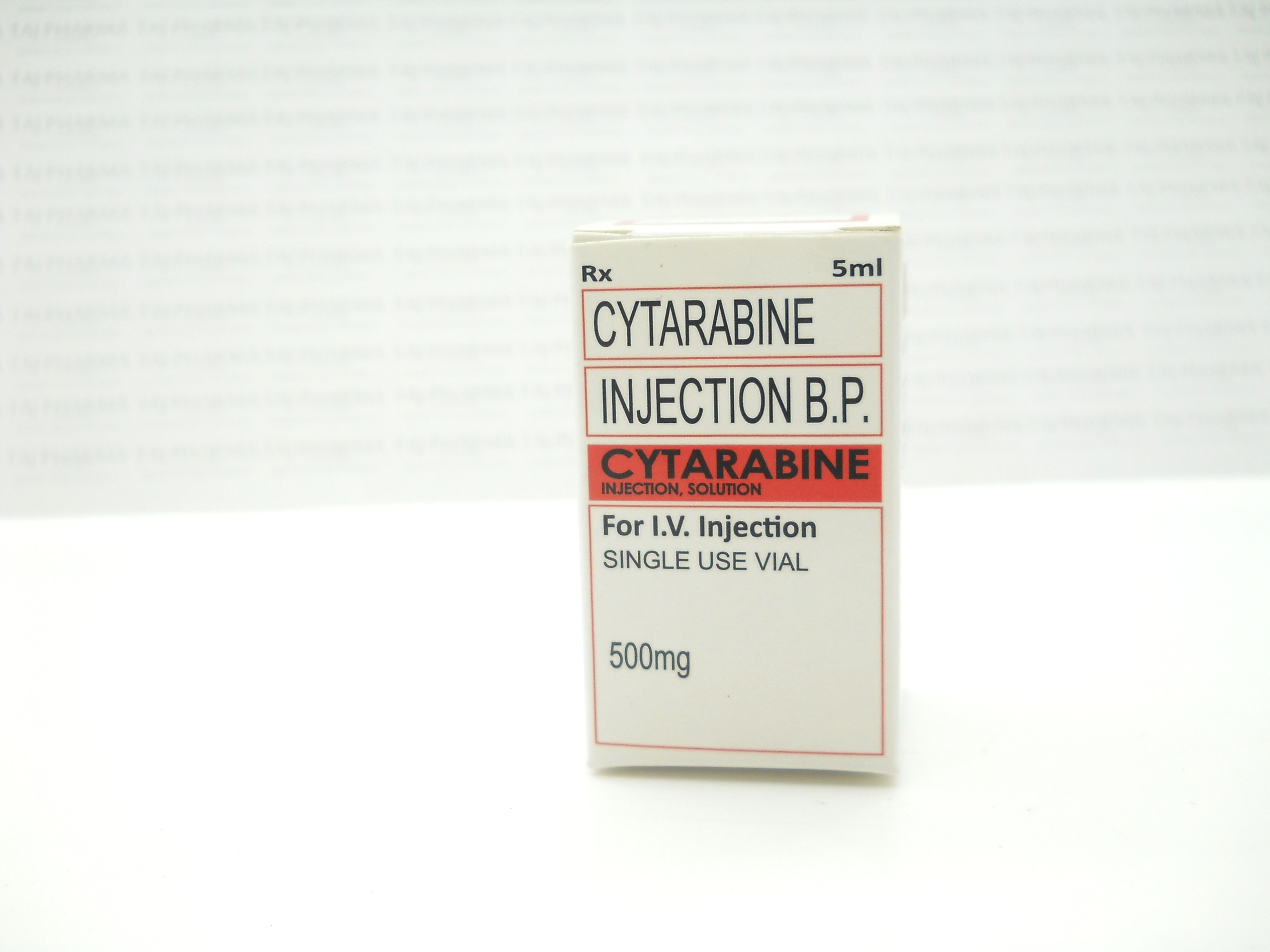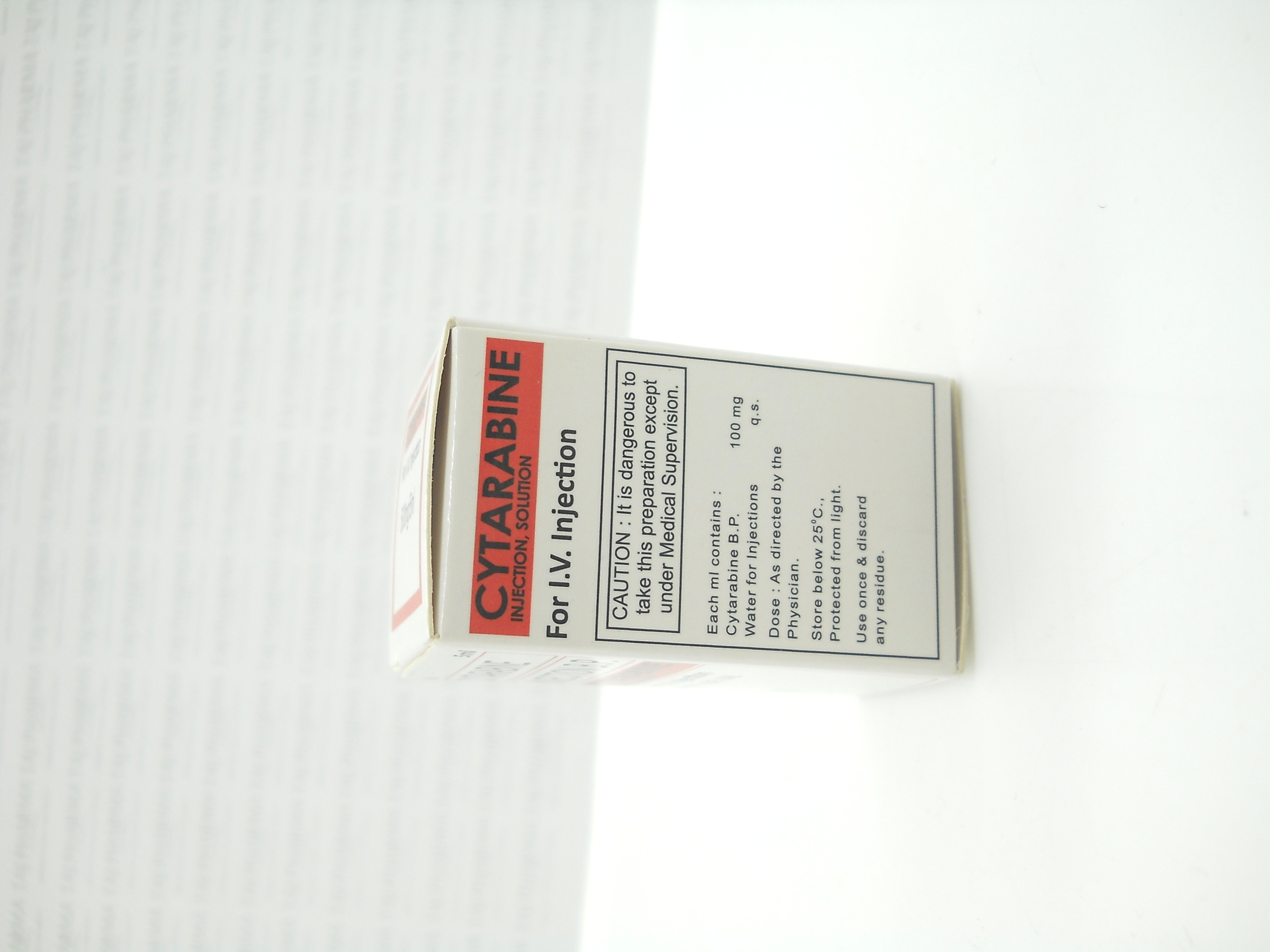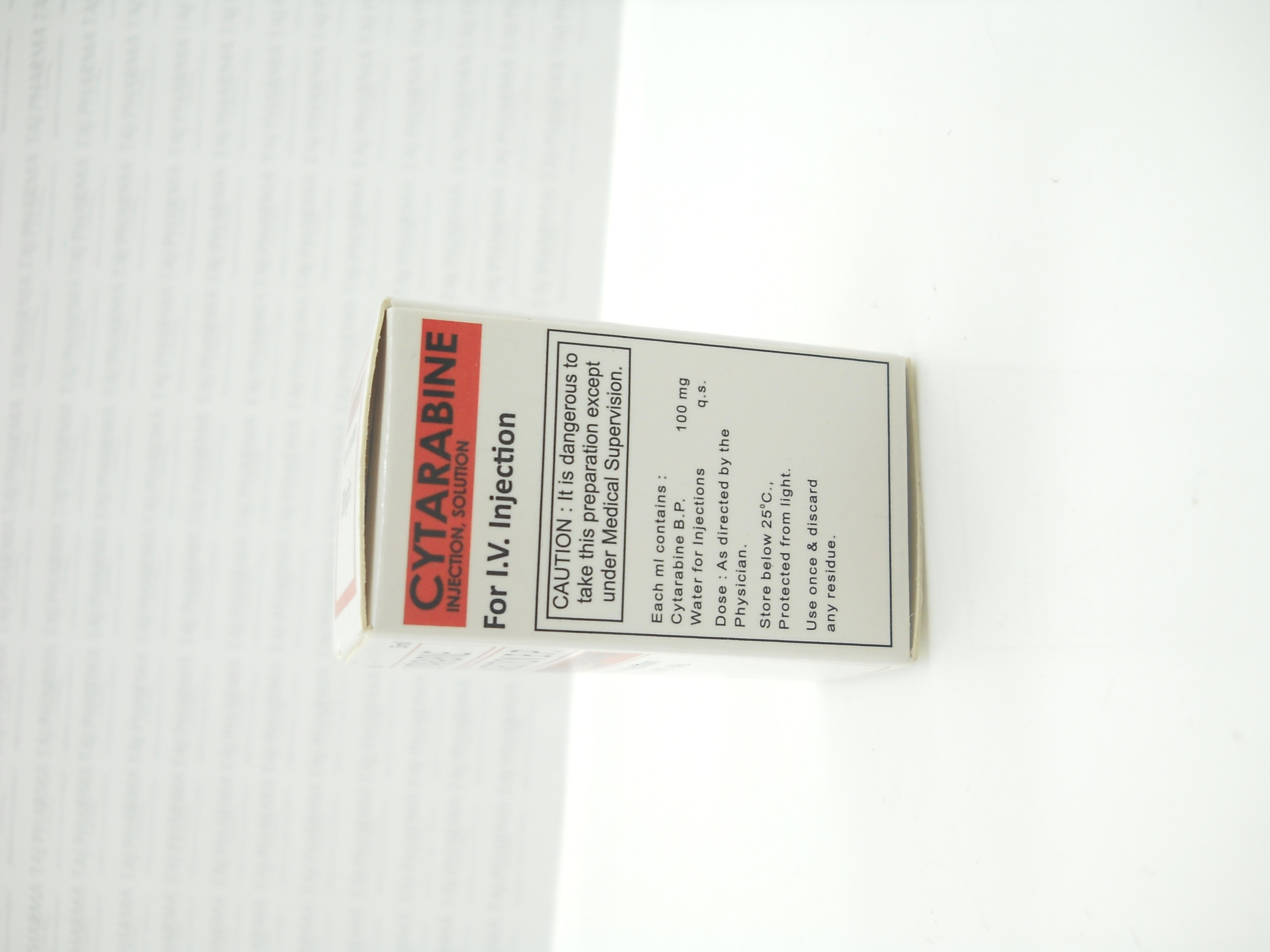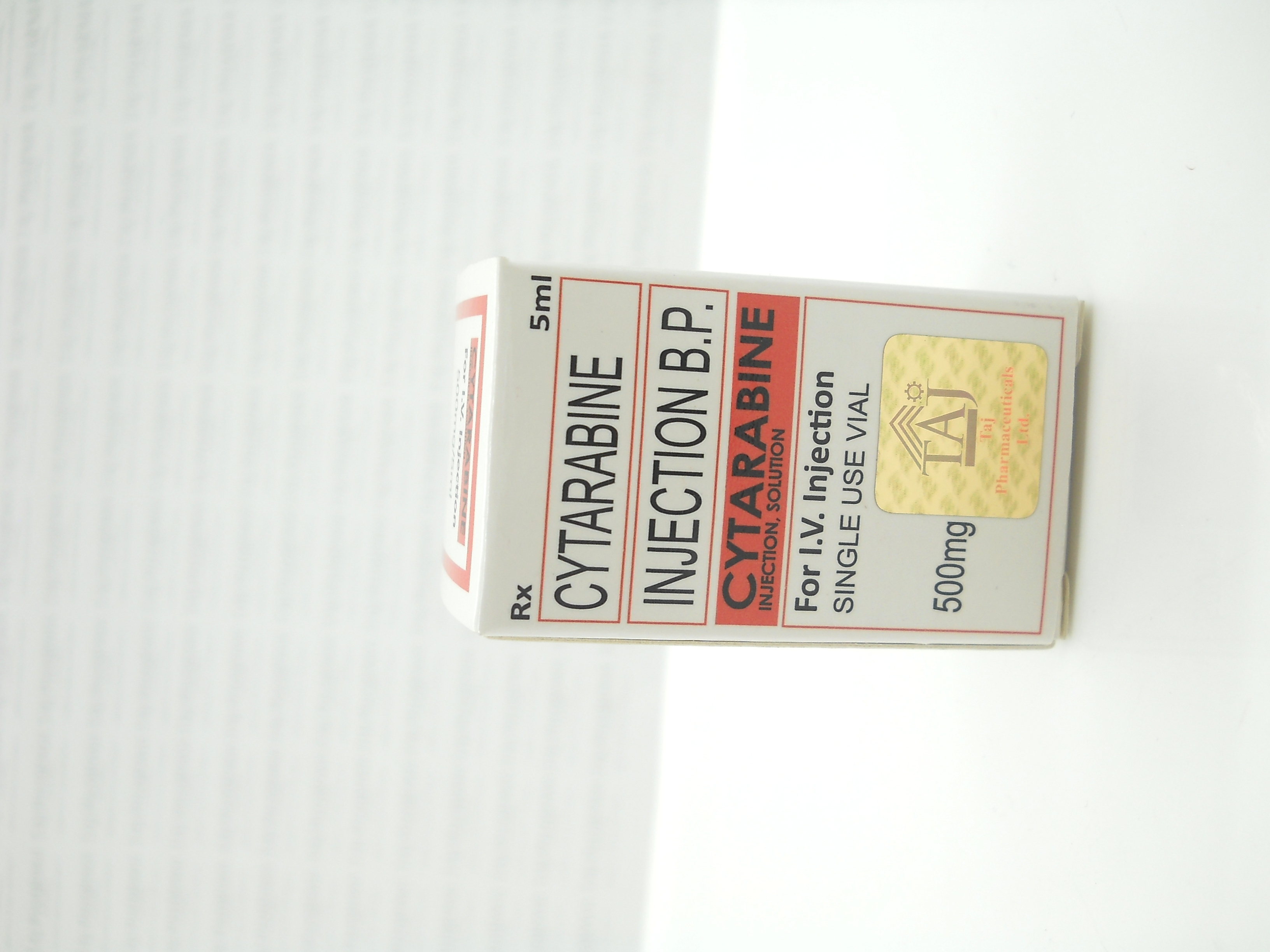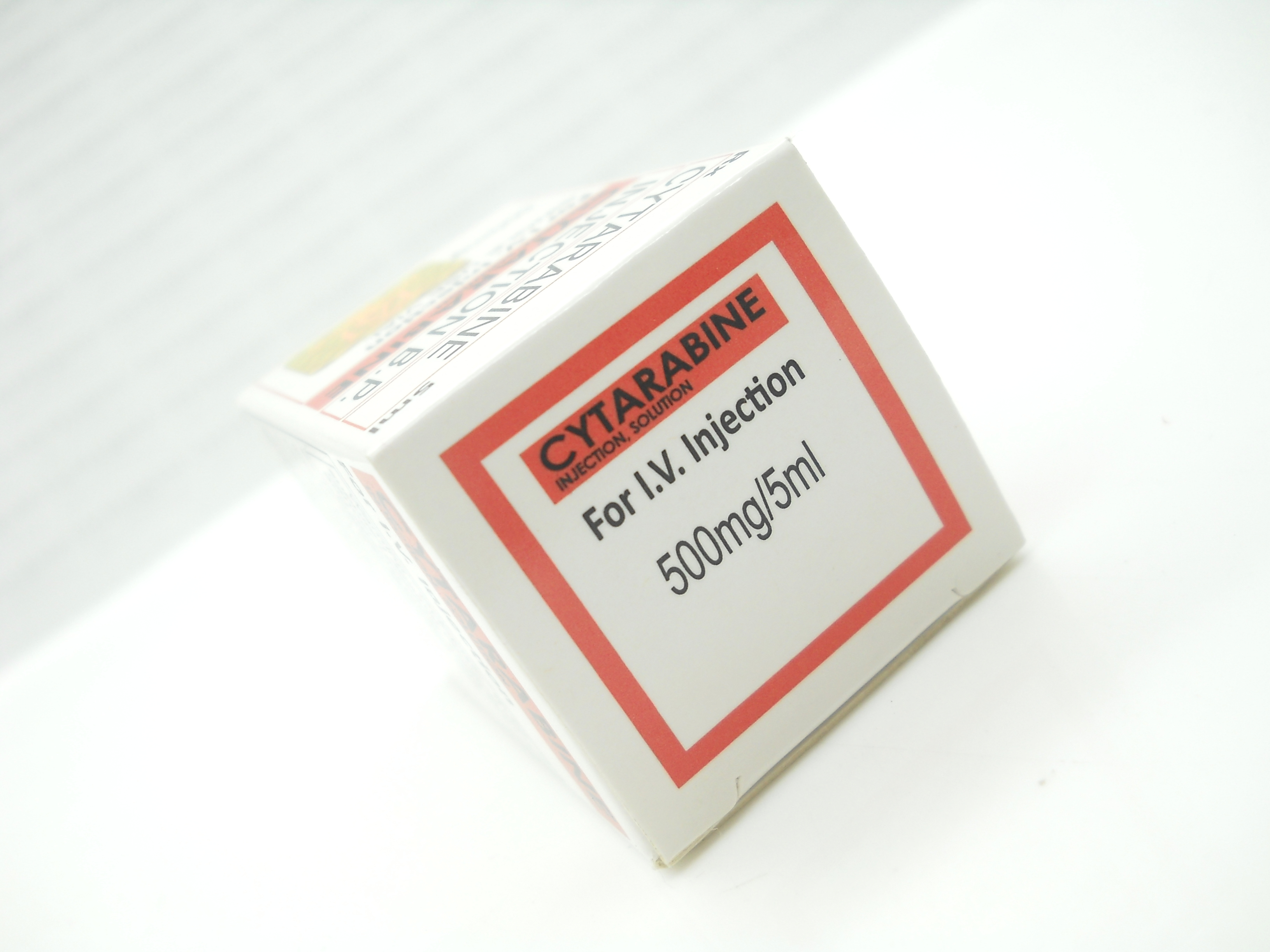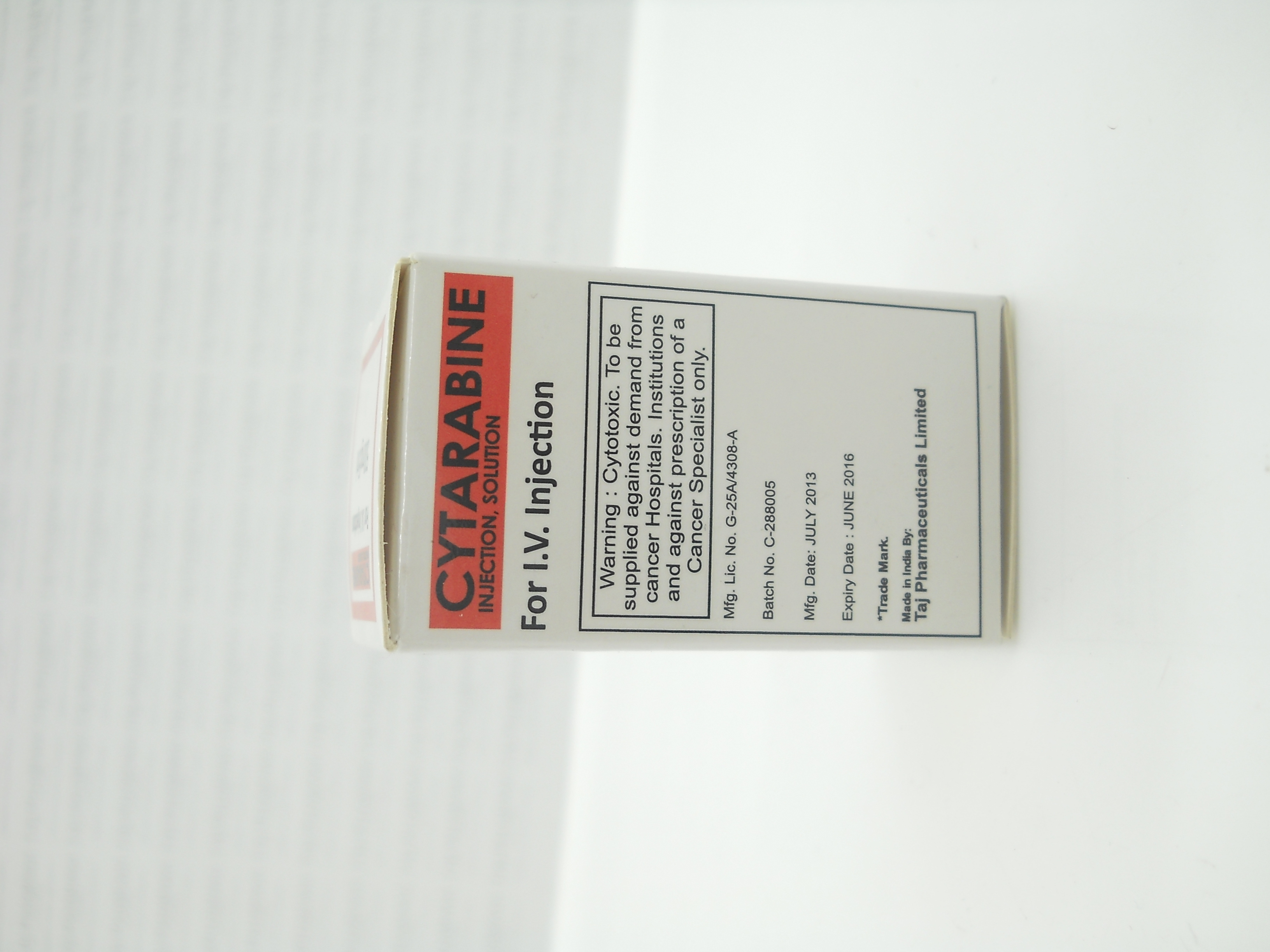Cytarabine 100mg/500mg Injection
Cytarabine
100mg / 500mg Injection
Cytarabine for Injection USP is available in vials containing 100 mg, 500 mg, 1 g, and 2 g cytarabine. When necessary, the pH of Cytarabine for Injection USP was adjusted with hydrochloric acid and/or sodium hydroxide. Reconstitute with Bacteriostatic Water for Injection USP with benzyl alchohol for intravenous and subcutaneous use only.
Do not use this diluent intrathecally.
Store at 20° to 25°C (68° to 77°F).[See USP Controlled Room Temperature].
WARNINGS
Only physicians experienced in cancer chemotherapy should use Cytarabine for Injection USP.
For induction therapy, patients should be treated in a facility with laboratory and supportive resources sufficient to monitor drug tolerance and protect and maintain a patient compromised by drug toxicity. The main toxic effect of cytarabine is bone marrow suppression with leukopenia, thrombocytopenia, and anemia. Less serious toxicity includes nausea, vomiting, diarrhea and abdominal pain, oral ulceration, and hepatic dysfunction.
The physician must judge possible benefit to the patient against known toxic effects of this drug in considering the advisability of therapy with cytarabine. Before making this judgement or beginning treatment, the physician should be familiar with the following text.
Cytarabine
100mg / 500mg Injection
What is in this Cytarabine
This leaflet answers some common questions about Cytarabine Injection. It does not contain all the available information. It does not take the place of talking to your doctor or pharmacist.
All medicines have benefits and risks. Your doctor has weighed the risks of you taking Cytarabine Injection against the benefits this medicine is expected to have for you.
This medicine will be used while you are at the clinic or in hospital. If possible, please read this leaflet carefully before this medicine is given to you. In some cases this leaflet may be given to you after the medicine has been used.
If you have any concerns about taking this medicine, ask your doctor or pharmacist.
Keep this leaflet.
You may need to read it again.
What Cytarabine Injection is used for
Cytarabine belongs to a group of medicines known as antineoplastics. It is used to treat cancer.
How Cytarabine Injection works
Cytarabine works by preventing the growth of cancer cells and eventually destroying them. It is used alone or in combination with other medicines to treat some cancers, particularly cancers of the blood (especially leukaemia).
Cytarabine Injection may be used to treat other conditions that are not mentioned above. Your doctor will be able to tell you about the specific condition for which you have been prescribed Cytarabine Injection.
This medicine is available only with a doctor's prescription.
Use in Children
Cytarabine Injection is also used in children to treat blood cancers such as leukaemia. It is also sometimes used in combination with other medicines to treat non-Hodgkins lymphoma.
Before you are given Cytarabine Injection
When you must not be given it
Do not have Cytarabine Injection if you have an allergy to:
- any medicine containing cytarabine
- any of the ingredients listed at the end of this leaflet
- some of the symptoms of an allergic reaction may include:
- shortness of breath
- wheezing or difficulty breathing
- swelling of the face, lips, tongue or other parts of the body
- rash, itching or hives on the skin.
Tell your doctor if you have been given cytarabine previously.
Do not have this medicine if you are pregnant or planning to fall pregnant.
Do not have this medicine if you are breastfeeding.
It is not known if cytarabine passes into breast milk.
If you are not sure whether you should be given Cytarabine Injection, speak to your doctor.
Before you are given it
Tell your doctor if you have allergies to any other medicines, foods, preservatives or dyes.
Tell your doctor if you have or have had any of the following medical conditions:
- liver disease or poor liver function
- kidney disease
- gout
- bleeding or bruising more easily than normal
- bone marrow suppression - decreased levels of cells in your bloodstream including white blood cells and platelets (cells involved in the blood clotting process) any sort of infection
Tell your doctor if you are pregnant or plan to become pregnant or are breast-feeding.
Your doctor can discuss with you the risks and benefits involved.
If you have not told your doctor about any of the above, tell him/ her before you are given Cytarabine Injection.
Taking other medicines
Tell your doctor if you are taking any other medicines, including any that you buy without a prescription from your pharmacy, supermarket or health food shop.
Some medicines may be affected by Cytarabine Injection or may affect how well it works. You may need different amounts of your medicines, or you may need to take different medicines. Your doctor will advise you.
Tell your doctor or pharmacist if you are taking any of the following:
- other medicines to treat cancer such as methotrexate.
- medicines to treat bacterial infections such as gentamicin
- vaccines (injections to prevent you getting a certain disease)
- digoxin, a medicine used to treat an irregular heart beat
You may need different amounts of your medicines or you may need to take different medicines. Your doctor will advise you.
How Cytarabine Injection is given
They may differ from the information contained in this leaflet.
Cytarabine is given by a slow injection into a vein or under the skin. Occasionally it may be injected directly into the fluid around the spine. Cytarabine must only be given by a doctor or nurse.
Your doctor will decide what dose, how often and how long you will receive it. This depends on your condition and other factors, such as your weight, age, blood tests and whether or not other medicines are being given at the same time.
Cytarabine Injection may be given alone or in combination with other drugs.
If you are given too much (overdose)
Overdose is unlikely as Cytarabine Injection is given in hospital under the supervision of a doctor, or nurse trained to administer medicine intravenously. However, if you are given too much cytarabine, you may experience some of the effects listed under "Side effects" below.
Immediately telephone your doctor or the Poisons Information for advice or go to Accident and Emergency at your nearest hospital if you think you may have been given too much cytarabine. Do this even if there are no signs of discomfort or poisoning.
Ask your doctor if you have any concerns.
Your doctor has information on how to recognise and treat an overdose.
While you are given Cytarabine Injection
Things you must do
Cytarabine can temporarily lower the number of white blood cells in your blood, increasing the chance of you getting an infection. It can also lower the number of platelets, which are necessary for proper blood clotting. If this occurs there are certain precautions you can take, especially when your white cell and/or platelet cell count is low, to reduce the risk of infection or bleeding:
- if you can, avoid people with infections. Check with your doctor if you think you are getting an infection or if you get
- a fever or chills, cough or hoarseness, lower back or side pain, or painful or difficult urination
- check with your doctor immediately if you notice any unusual bleeding or bruising; black, tarry stools; blood in urine or stools; or pinpoint red spots on your skin
- be careful when using a regular toothbrush, dental floss or toothpick. Your doctor, dentist, or nurse may recommend other ways to clean your teeth and gums. Check with your medical doctor before having any dental work done
- do not touch your eyes or the inside of your nose unless you have just washed your hands and have not touched anything else in the meantime
- be careful not to cut yourself when you are using sharp objects such as a safety razor or fingernail or toenail cutters
- avoid contact sports or other situations where bruising or injury could occur.
If you are about to be started on any new medicine, remind your doctor and pharmacist that you are being given Cytarabine Injection.
Do not have any immunisations (vaccinations) without your doctor's approval.
Cytarabine may lower your body's resistance and there is a chance you may get the infection the immunisation is meant to prevent.
Tell any other doctors, dentists, and pharmacists who treat you that you are being given this medicine.
If you are going to have surgery, tell the surgeon or anaesthetist that you are being given this medicine.
It may affect other medicines used during surgery.
If you fall pregnant while receiving this medicine, tell your doctor immediately.
If you are about to have any blood tests, tell your doctor that you are receiving this medicine.
It may interfere with the results of certain tests.
Keep all of your doctor's appointments so that your progress can be checked.
Your doctor may do certain tests from time to time to make sure the medicine is working and to prevent unwanted side effects.
Things to be careful of
Be careful driving or operating machinery until you know how Cytarabine Injection affects you.
You may feel tired and weaker while you are receiving a course of cytarabine therapy.
While you are receiving this medicine, your doctor may want you to drink extra fluids so you will pass more urine. This will help prevent kidney problems and keep your kidneys working well.
Side effects
Tell your doctor, nurse or pharmacist as soon as possible if you do not feel well while you are being given Cytarabine Injection.
Like other medicines, cytarabine can cause some side effects. Some of these side effects may be prevented or treated with other medicines. If side effects do occur, their severity usually depends on the dose of cytarabine you receive. Some may be serious and need medical attention.
It can be difficult to tell whether side effects are the result of having Cytarabine Injection, effects of your condition or side effects of other medicines you may be taking. For this reason it is important to tell your doctor of any change in your condition.
Ask your doctor, nurse or pharmacist to answer any questions that you may have.
Do not be alarmed by this list of possible side effects. You may not experience any of them.
Tell your doctor if
Tell your doctor, nurse or pharmacist if you notice any of the following and they worry you:
- nausea, vomiting or diarrhoea
- oral and anal ulcers or inflammation
- loss of appetite
- hair loss, especially of the scalp
- rash
- fever and chills, sweats or feel generally unwell
- muscle or bone pain
- swelling and redness along a vein which is extremely tender when touched
- swelling and redness along a vein which is extremely tender when touched
- conjunctivitis (itchy eyes with a discharge)
- bleeding.
These are more common side effects.
Tell your doctor as soon as possible if
Tell your doctor as soon as possible if you notice any of the following:
- severe nausea, vomiting or diarrhoea
- swelling of the face, lips or tongue, or wheezing or shortness of breath after being given cytarabine
- sore throat
- unusual bleeding or bruising
- chest pain or stomach pain, heartburn
- itchy red rash, hives, freckling, ulcers
- yellowing of the skin
- infections including a cough
- difficulty passing urine
- tiredness, headaches, shortness of breath, dizziness, looking pale
- pain, hotness or redness at site of injection
- mood swings or personality changes
- numbness or weakness
- difficulty with your vision
This list includes serious side effects that may require medical attention.
Go to hospital if
Tell your doctor immediately or go to Accident and Emergency at your nearest hospital, if you notice any of the following:
- difficulty breathing
- seizures
- severe stomach pain
This list includes very serious side effects. You may need urgent medical attention or hospitalisation.
Tell your doctor or pharmacist if you notice anything else that is making you feel unwell.
Other side effects not listed above may also occur in some people. Some of these side effects, for example changes in liver, kidney or bone marrow function, can only be found when your doctor does tests from time to time to check your progress.
Storage
Cytarabine Injection will be stored in the pharmacy or on the ward. It is kept in a cool dry place, protected from light, where the temperature stays between 15- 25°C. Available Dosage forms
- Cytarabine Injection 100 mg in 1mL (sterile) Vial
- Cytarabine Injection 500 mg in 5 mL (sterile) Vial
- Cytarabine Injection 1 g in 10 mL (sterile) Vial
Product Description
What it looks like
Cytarabine Injection is a clear solution in a plastic vial.
Ingredients
Cytarabine Injection contains Cytarabine 20 mg/mL with Sodium Chloride in Water for Injections or Cytarabine 100 mg/mL in Water for Injections.
It does not contain a preservative.
Cytarabine
100mg / 500mg Injection
WARNING
Only physicians experienced in cancer chemotherapy should use Cytarabine Injection.
For induction therapy patients should be treated in a facility with laboratory and supportive resources sufficient to monitor drug tolerance and protect and maintain a patient compromised by drug toxicity. The main toxic effect of Cytarabine Injection is bone marrow suppression with leukopenia, thrombocytopenia and anemia. Less serious toxicity includes nausea, vomiting, diarrhea and abdominal pain, oral ulceration, and hepatic dysfunction.
The physician must judge possible benefit to the patient against known toxic effects of this drug in considering the advisability of therapy with Cytarabine Injection. Before making this judgement or beginning treatment, the physician should be familiar with the following text.
DESCRIPTION
Cytarabine Injection, an antineoplastic, is a sterile isotonic solution for intravenous and subcutaneous use, which contains no preservative and is available in 20 mg/mL (1000 mg/50 mL) Pharmacy Bulk Package.
A Pharmacy Bulk Package is a container of a sterile preparation for parenteral use that contains many single doses. The contents are intended for use in a pharmacy admixture program and are restricted to the preparation of admixtures for intravenous infusion.
Each mL contains 20 mg Cytarabine, USP and the following inactive ingredients: sodium chloride 0.68% and Water for Injection q.s. When necessary, the pH is adjusted with hydrochloric acid and/or sodium hydroxide to a target pH of 7.4. Each vial contains approximately 5.82 mEq sodium.
Cytarabine is chemically 4-amino-1-?-D-arabinofuranosyl-2(1H)-pyrimidinone. The structural formula is:

Cytarabine is an odorless, white to off-white, crystalline powder which is freely soluble in water and slightly soluble in alcohol and in chloroform.
CLINICAL PHARMACOLOGY
Cell Culture Studies:
Cytarabine is cytotoxic to a wide variety of proliferating mammalian cells in culture. It exhibits cell phase specificity, primarily killing cells undergoing DNA synthesis (S-phase) and under certain conditions blocking the progression of cells from the G1 phase to the S-phase. Although the mechanism of action is not completely understood, it appears that cytarabine acts through the inhibition of DNA polymerase. A limited, but significant, incorporation of cytarabine into both DNA and RNA has also been reported. Extensive chromosomal damage, including chromatoid breaks, have been produced by cytarabine and malignant transformation of rodent cells in culture has been reported. Deoxycytidine prevents or delays (but does not reverse) the cytotoxic activity.
Cellular Resistance and Sensitivity:
Cytarabine is metabolized by deoxycytidine kinase and other nucleotide kinases to the nucleotide triphosphate, an effective inhibitor of DNA polymerase; it is inactivated by a pyrimidine nucleoside deaminase which converts it to the nontoxic uracil derivative. It appears that the balance of kinase and deaminase levels may be an important factor in determining sensitivity or resistance of the cell to cytarabine.
Human Pharmacology:
Cytarabine is rapidly metabolized and is not effective orally; less than 20 percent of the orally administered dose is absorbed from the gastrointestinal tract.
Following rapid intravenous injection of cytarabine, labeled with tritium, the disappearance from plasma is biphasic. There is an initial distributive phase with a half-life of about 10 minutes, followed by a second elimination phase with a half-life of about 1 to 3 hours. After the distributive phase, more than 80 percent of plasma radioactivity can be accounted for by the inactive metabolite 1- ? -D-arabinofuranosyluracil (ara-U). Within 24 hours about 80 percent of the administered radioactivity can be recovered in the urine, approximately 90 percent of which is excreted as ara-U.
Relatively constant plasma levels can be achieved by continuous intravenous infusion.
After subcutaneous or intramuscular administration of cytarabine labeled with tritium, peak-plasma levels of radioactivity are achieved about 20 to 60 minutes after injection and are considerably lower than those after intravenous administration.
Cerebrospinal fluid levels of cytarabine are low in comparison to plasma levels after single intravenous injection. However, in one patient in whom cerebrospinal levels were examined after 2 hours of constant intravenous infusion, levels approached 40 percent of the steady state plasma level. With intrathecal administration, levels of cytarabine in the cerebrospinal fluid declined with a first order half-life of about 2 hours. Because cerebrospinal fluid levels of deaminase are low, little conversion to ara-U was observed.
Immunosuppressive Action:
Cytarabine is capable of obliterating immune responses in man during administration with little or no accompanying toxicity. Suppression of antibody responses to E. coli-VI antigen and tetanus toxoid have been demonstrated. This suppression was obtained during both primary and secondary antibody responses.
Cytarabine also suppressed the development of cell-mediated responses such as delayed hypersensitivity skin reaction to dinitrochlorobenzene. However, it had no effect on already established delayed hypersensitivity reactions.
Following 5-day courses of intensive therapy with cytarabine, the immune response was suppressed, as indicated by the following parameters: macrophage ingress into skin windows; circulating antibody response following primary antigenic stimulation; lymphocyte blastogenesis with phytohemagglutinin. A few days after termination of therapy there was a rapid return to normal.
INDICATIONS AND USAGE
Cytarabine in combination with other approved anticancer drugs is indicated for remission induction in acute non-lymphocytic leukemia of adults and children. It has also been found useful in the treatment of acute lymphocytic leukemia and the blast phase of chronic myelocytic leukemia. Intrathecal administration of cytarabine is indicated in the prophylaxis and treatment of meningeal leukemia.
CONTRAINDICATIONS
Cytarabine Injection is contraindicated in those patients who are hypersensitive to the drug.
WARNINGS
(See boxed WARNING)
Cytarabine is a potent bone marrow suppressant. Therapy should be started cautiously in patients with pre-existing drug-induced bone marrow suppression. Patients receiving this drug must be under close medical supervision and, during induction therapy, should have leucocyte and platelet counts performed daily. Bone marrow examinations should be performed frequently after blasts have disappeared from the peripheral blood. Facilities should be available for management of complications, possibly fatal, of bone marrow suppression (infection resulting from granulocytopenia and other impaired body defenses, and hemorrhage secondary to thrombocytopenia). One case of anaphylaxis that resulted in acute cardiopulmonary arrest and required resuscitation has been reported. This occurred immediately after the intravenous administration of cytarabine.
Severe and at times fatal CNS, GI and pulmonary toxicity (different from that seen with conventional therapy regimens of cytarabine) has been reported following some experimental cytarabine dose schedules. These reactions include reversible corneal toxicity, and hemorrhagic conjunctivitis, which may be prevented or diminished by prophylaxis with a local corticosteroid eye drop; cerebral and cerebellar dysfunction, including personality changes, somnolence and coma, usually reversible; severe gastrointestinal ulceration, including pneumatosis cystoides intestinalis leading to peritonitis; sepsis and liver abscess; pulmonary edema, liver damage with increased hyperbilirubinemia; bowel necrosis; and necrotizing colitis. Rarely, severe skin rash, leading to desquamation has been reported. Complete alopecia is more commonly seen with experimental high dose therapy than with standard cytarabine treatment programs. If experimental high dose therapy is used, do not use a diluent containing benzyl alcohol.
Cases of cardiomyopathy with subsequent death has been reported following experimental high dose therapy with cytarabine in combination with cyclophosphamide when used for bone marrow transplant preparation.
A syndrome of sudden respiratory distress, rapidly progressing to pulmonary edema and radiographically pronounced cardiomegaly has been reported following experimental high dose therapy with cytarabine used for the treatment of relapsed leukemia from one institution in 16/72 patients. The outcome of this syndrome can be fatal.
Two patients with childhood acute myelogenous leukemia who received intrathecal and intravenous cytarabine at conventional doses (in addition to a number of other concomitantly administered drugs) developed delayed progressive ascending paralysis resulting in death in one of the two patients.
Use in Pregnancy (Category D):
Cytarabine Injection can cause fetal harm when administered to a pregnant woman. Cytarabine causes abnormal cerebellar development in the neonatal hamster and is teratogenic to the rat fetus. There are no adequate and well-controlled studies in pregnant women. Women of childbearing potential should be advised to avoid becoming pregnant.
PRECAUTIONS
1. General Precautions:Patients receiving Cytarabine Injection must be monitored closely. Frequent platelet and leukocyte counts and bone marrow examinations are mandatory. Consider suspending or modifying therapy when drug-induced marrow depression has resulted in a platelet count under 50,000 or a polymorphonuclear granulocyte count under 1000/mm3. Counts of formed elements in the peripheral blood may continue to fall after the drug is stopped and reach lowest values after drug-free intervals of 12 to 24 days. When indicated, restart therapy when definite signs of marrow recovery appear (on successive bone marrow studies). Patients whose drug is withheld until “normal” peripheral blood values are attained may escape from control.
When large intravenous doses are given quickly, patients are frequently nauseated and may vomit for several hours postinjection. This problem tends to be less severe when the drug is infused.
The human liver apparently detoxifies a substantial fraction of an administered dose. In particular, patients with renal or hepatic function impairment may have a higher likelihood of CNS toxicity after high-dose cytarabine treatment. Use the drug with caution and possibly at reduced dose in patients whose liver or kidney function is poor.
Periodic checks of bone marrow, liver and kidney functions should be performed in patients receiving Cytarabine Injection.
Like other cytotoxic drugs, Cytarabine Injection may induce hyperuricemia secondary to rapid lysis of neoplastic cells. The clinician should monitor the patient’s blood uric acid level and be prepared to use such supportive and pharmacologic measures as might be necessary to control this problem.
Acute pancreatitis has been reported to occur in a patient receiving cytarabine by continuous infusion and in patients being treated with cytarabine who have had prior treatment with L-asparaginase.
2. Information for patient:Not applicable.
3. Laboratory tests:See General Precautions.
4. Drug Interactions:Reversible decreases in steady-state plasma digoxin concentrations and renal glycoside excretion were observed in patients receiving beta-acetyldigoxin and chemotherapy regimens containing cyclophosphamide, vincristine and prednisone with or without cytarabine or procarbazine. Steady-state plasma digitoxin concentrations did not appear to change. Therefore, monitoring of plasma digoxin levels may be indicated in patients receiving similar combination chemotherapy regimens. The utilization of digitoxin for such patients may be considered as an alternative.
An in vitrointeraction study between gentamicin and cytarabine showed a cytarabine related antagonism for the susceptibility of K. pneumoniae strains. This study suggests that in patients on cytarabine being treated with gentamicin for a K. pneumoniae infection, the lack of a prompt therapeutic response may indicate the need for reevaluation of antibacterial therapy.
Clinical evidence in one patient showed possible inhibition of fluorocytosine efficacy during therapy with cytarabine. This may be due to potential competitive inhibition of its uptake.
5. Carcinogenesis, mutagenesis, impairment of fertility:Extensive chromosomal damage, including chromatoid breaks have been produced by cytarabine and malignant transformation of rodent cells in culture has been reported.
6. Pregnancy:Pregnancy Category D. See WARNINGS. A review of the literature has shown 32 reported cases where cytarabine was given during pregnancy, either alone or in combination with other cytotoxic agents.
Eighteen normal infants were delivered. Four of these had first trimester exposure. Five infants were premature or of low birth weight. Twelve of the 18 normal infants were followed up at ages ranging from six weeks to seven years, and showed no abnormalities. One apparently normal infant died at 90 days of gastroenteritis.
Two cases of congenital abnormalities have been reported, one with upper and lower distal limb defects, and the other with extremity and ear deformities. Both of these cases had first trimester exposure.
There were seven infants with various problems in the neonatal period, including pancytopenia; transient depression of the WBC, hematocrit or platelets; electrolyte abnormalities; transient eosinophilia; and one case of increased IgM levels and hyperpyrexia possibly due to sepsis. Six of the seven infants were also premature. The child with pancytopenia died at 21 days of sepsis.
Therapeutic abortions were done in five cases. Four fetuses were grossly normal, but one had an enlarged spleen and another showed Trisomy C chromosome abnormality in the chorionic tissue.
Because of the potential for abnormalities with cytotoxic therapy, particularly during the first trimester, a patient who is or who may become pregnant while on Cytarabine Injection should be apprised of the potential risk to the fetus and the advisability of pregnancy continuation. There is a definite, but considerably reduced risk if therapy is initiated during the second or third trimester. Although normal infants have been delivered to patients treated in all three trimesters of pregnancy, follow-up of such infants would be advisable.
7. Labor and delivery:Not applicable.
8. Nursing mothers:It is not known whether this drug is excreted in human milk. Because many drugs are excreted in human milk and because of the potential for serious adverse reactions in nursing infants from cytarabine, a decision should be made whether to discontinue nursing or to discontinue the drug, taking into account the importance of the drug to the mother.
9. Pediatric use:See INDICATIONS AND USAGE.
ADVERSE REACTIONS
Expected Reactions: Because cytarabine is a bone marrow suppressant, anemia, leukopenia, thrombocytopenia, megaloblastosis and reduced reticulocytes can be expected as a result of administration with cytarabine. The severity of these reactions are dose and schedule dependent. Cellular changes in the morphology of bone marrow and peripheral smears can be expected.
Following 5-day constant infusions or acute injections of 50 mg/m2 to 600 mg/m2, white cell depression follows a biphasic course. Regardless of initial count, dosage level, or schedule, there is an initial fall starting the first 24 hours with a nadir at days 7-9. This is followed by a brief rise which peaks around the twelfth day. A second and deeper fall reaches nadir at days 15-24. Then there is a rapid rise to above baseline in the next 10 days. Platelet depression is noticeable at 5 days with a peak depression occurring between days 12-15. Thereupon, a rapid rise to above baseline occurs in the next 10 days.
Infectious Complications Infection:
Viral, bacterial, fungal, parasitic, or saprophytic infections, in any location in the body may be associated with the use of cytarabine alone or in combination with other immunosuppressive agents following immunosuppressant doses that affect cellular or humoral immunity. These infections may be mild, but can be severe and at times fatal.
The Cytarabine (Ara-C) Syndrome:
A cytarabine syndrome has been described by Castleberry. It is characterized by fever, myalgia, bone pain, occasionally chest pain, maculopapular rash, conjunctivitis and malaise. It usually occurs 6-12 hours following drug administration. Corticosteroids have been shown to be beneficial in treating or preventing this syndrome. If the symptoms of the syndrome are deemed treatable, corticosteroids should be contemplated as well as continuation of therapy with Cytarabine Injection.
Most Frequent Adverse Reactions:
Anorexia, hepatic dysfunction, nausea, fever, vomiting, rash, diarrhea, thrombophlebitis, oral and anal inflammation or ulceration, bleeding (all sites). Nausea and vomiting are most frequent following rapid intravenous injection.
Less Frequent Adverse Reactions:
Sepsis, abdominal pain, pneumonia, freckling, cellulitis at injection site, jaundice, skin ulceration, conjunctivitis (may occur with rash), urinary retention, dizziness, renal dysfunction, alopecia, neuritis, anaphylaxis, neural toxicity, allergic edema, sore throat, pruritus, esophageal ulceration, shortness of breath, esophagitis, urticaria, chest pain, pericarditis, headache, bowel necrosis, pancreatitis.
Experimental Doses:
Severe and at times fatal CNS, GI and pulmonary toxicity (different from that seen with conventional therapy regimens of cytarabine) has been reported following some experimental dose schedules of Cytarabine. These reactions include reversible corneal toxicity and hemorrhagic conjunctivitis, which may be prevented or diminished by prophylaxis with a local corticosteroid eye drop; cerebral and cerebellar dysfunction, including personality changes, somnolence and coma, usually reversible; severe gastrointestinal ulceration, including pneumatosis cystoides intestinalis leading to peritonitis; sepsis and liver abscess; pulmonary edema, liver damage with increased hyperbilirubinemia; bowel necrosis; and necrotizing colitis. Rarely, severe skin rash, leading to desquamation has been reported. Complete alopecia is more commonly seen with experimental high dose therapy than with standard cytarabine treatment programs. If experimental high dose therapy is used, do not use a diluent containing benzyl alcohol.
Cases of cardiomyopathy with subsequent death has been reported following experimental high dose therapy with cytarabine in combination with cyclophosphamide when used for bone marrow transplant preparation. This cardiac toxicity may be schedule dependent.
A syndrome of sudden respiratory distress, rapidly progressing to pulmonary edema and radiographically pronounced cardiomegaly has been reported following experimental high dose therapy with cytarabine used for the treatment of relapsed leukemia from one institution in 16/72 patients. The outcome of this syndrome can be fatal.
Two patients with adult acute non-lymphocytic leukemia developed peripheral motor and sensory neuropathies after consolidation with high-dose cytarabine, daunorubicin, and asparaginase. Patients treated with high-dose cytarabine should be observed for neuropathy since dose schedule alterations may be needed to avoid irreversible neurologic disorders.
Ten patients treated with experimental intermediate doses of cytarabine (1 g/m2) with and without other chemotherapeutic agents (meta-AMSA, daunorubicin, etoposide) at various dose regimens developed a diffuse interstitial pneumonitis without clear cause that may have been related to the cytarabine.
Two cases of pancreatitis have been reported following experimental doses of cytarabine and numerous other drugs. Cytarabine could have been the causative agent.
OVERDOSAGE
There is no antidote for cytarabine overdosage. Doses of 4.5 g/m2 by intravenous infusion over 1 hour every 12 hours for 12 doses has caused an unacceptable increase in irreversible CNS toxicity and death.
Single doses as high as 3 g/m2 have been administered by rapid intravenous infusion without apparent toxicity.
DOSAGE AND ADMINISTRATION
Cytarabine Injection (non-preserved) can be administered by intravenous injection or infusion, subcutaneously, or intrathecally. However, the intent of this Pharmacy Bulk Package is for the preparation of solutions for IV infusion only. Intrathecal use of cytarabine requires the use of single-dose, unpreserved solutions only.
Cytarabine Injection is not active orally. The schedule and method of administration varies with the program of therapy to be used. While Cytarabine Injection may be given by intravenous infusion or injection, or subcutaneously or intrathecally, THE PURPOSE OF THE PHARMACY BULK PACKAGE IS FOR THE PREPARATION OF INTRAVENOUS INFUSIONS. Thrombophlebitis has occurred at the site of drug injection or infusion in some patients, and rarely patients have noted pain and inflammation at subcutaneous injection sites. In most instances, however, the drug has been well tolerated.
Patients can tolerate higher total doses when they receive the drug by rapid intravenous injection as compared with slow infusion. This phenomenon is related to the drug’s rapid inactivation and brief exposure of susceptible normal and neoplastic cells to significant levels after rapid injection. Normal and neoplastic cells seem to respond in somewhat parallel fashion to these different modes of administration and no clear-cut clinical advantage has been demonstrated for either.
In the induction therapy of acute non-lymphocytic leukemia, the usual cytarabine dose in combination with other anti-cancer drugs is 100 mg/m2/day by continuous IV infusion (Days 1-7) or 100 mg/m2 IV every 12 hours (Days 1-7).
The literature should be consulted for the current recommendations for use in acute lymphocytic leukemia.
Intrathecal Use in Meningeal Leukemia:
Cytarabine has been used intrathecally in acute leukemia in doses ranging from 5 mg/m2 to 75 mg/m2 of body surface area. The frequency of administration varied from once a day for 4 days to once every 4 days. The most frequently used dose was 30 mg/m2 every 4 days until cerebrospinal fluid findings were normal, followed by one additional treatment. The dosage schedule is usually governed by the type and severity of central nervous system manifestations and the response to previous therapy.
If used intrathecally, do not use a solution containing benzyl alcohol. This pharmacy bulk package is not intended to be used for the preparation of intrathecal doses.
Cytarabine given intrathecally may cause systemic toxicity and careful monitoring of the hemopoietic system is indicated. Modification of other anti-leukemia therapy may be necessary. Major toxicity is rare. The most frequently reported reactions after intrathecal administration were nausea, vomiting and fever; these reactions are mild and self-limiting. Paraplegia has been reported. Necrotizing leukoencephalopathy occurred in 5 children; these patients had also been treated with intrathecal methotrexate and hydrocortisone, as well as by central nervous system radiation. Isolated neurotoxicity has been reported. Blindness occurred in two patients in remission whose treatment had consisted of combination systemic chemotherapy, prophylactic central nervous system radiation and intrathecal cytarabine.
When cytarabine is administered both intrathecally and intravenously within a few days, there is an increased risk of spinal cord toxicity, however, in serious life-threatening disease, concurrent use of intravenous and intrathecal cytarabine is left to the discretion of the treating physician.
Focal leukemic involvement of the central nervous system may not respond to intrathecal cytarabine and may better be treated with radiotherapy.
Chemical Stability of Infusion Solutions:
Chemical stability studies were performed by a stability indicating HPLC assay on Cytarabine Injection in infusion solutions. These studies showed that when Cytarabine Injection was diluted with Water for Injection, 5% Dextrose Injection or Sodium Chloride Injection, in both glass and plastic infusion bags, 97-100% of the cytarabine was present after 8 days storage at room temperature.
This chemical stability information in no way indicates that it would be acceptable practice to infuse a cytarabine admixture well after the preparation time. Good professional practice suggests that administration of an admixture should be as soon after preparation as feasible.
Parenteral drugs should be inspected visually for particulate matter and discoloration prior to administration, whenever solution and container permit.
Handling and Disposal:
Procedures for proper handling and disposal of anti-cancer drugs should be considered. Several guidelines on this subject have been published.1-7 There is no general agreement that all of the procedures recommended in the guidelines are necessary or appropriate.
Direction for Dispensing From Pharmacy Bulk Package:
The 50 mL Pharmacy Bulk Package is for use in the Pharmacy Admixtures Service only. The vials should be inserted into the plastic handling device provided, suspended as a unit in the laminar flow hood.
A single entry through the vial closure should be made with a sterile dispensing set or transfer device. Transfer individual doses to appropriate intravenous infusion solutions. Use of a syringe with needle is not recommended. Multiple entries will increase the potential of microbial and particulate contamination.
The above process should be carried out under a laminar flow hood using aseptic technique. Care should be exercised to protect personnel from aerosolized drug. Discard any unused portion within 4 hours after initial closure entry.
HOW SUPPLIED
Cytarabine Injection, PHARMACY BULK PACKAGE. Sterile, Isotonic Solution. Preservative Free.
Cytarabine Injection 20 mg/mL (1000 mg) in a 50 mL flip-top vial (green cap), packaged individually. Store product at controlled room temperature, 15° - 30°C (59° - 86°F).
REFERENCES
- Recommendations for the Safe handling of Parenteral Antineoplastic Drugs, NIH Publications No. 83-2621. For sale by the Superintendent of Documents, U.S. Government Printing Office, Washington, D.C. 20402.
- AMA Council Report, Guidelines for Handling Parenteral Antineoplastics, JAMA, 1985; 2.53 (11): 1590-1592.
- National Study Commission on Cytotoxic Exposure - Recommendations for Handling Cytotoxic Agents. Available from Louis P. Jeffrey, ScD., Chairman, National Study Commission on Cytotoxic Exposure, Massachusetts College of Pharmacy and Allied Health Sciences, 179 Longwood Avenue, Boston, Massachusetts 02115.
- Clinical Oncological Society of Australia, Guidelines and Recommendations for Safe handling of Antineoplastic Agents. Med J Australia, 1983; 1:426-428.
- Jones RB, et al: Safe Handling of Chemotherapeutic Agents: A Report from the Mount Sinai Medical Center. CA-A Cancer Journal of Clinicians, 1983; (Sept/Oct) 258-263.
- American Society of Hospital Pharmacists Technical Assistance Bulletin on Handling Cytotoxic and Hazardous Drugs. Am J. Hosp. Pharm, 1990; 47:1033-1049.
- Controlling Occupational Exposure to Hazardous Drugs. (OSHA Work Practice Guidelines), Am J. Health- Syst Pharm, 1996; 53: 1669-1685.
Product Glimpse
Description
We are committed to work towards a healthier and happier world. The company is an integrated, research based international pharmaceutical company, producing a wide range of quality, affordable generic (Cytarabine 100mg/500mg Injection) medicines, trusted by health-care professionals and patients across geographies.
We offer you the highest quality new Generic medicines ie. Cytarabine 100mg/500mg Injection, drugs and also with innovative packing at the lowest prices shipped to you from India. Browse our latest Pharmaceuticals and Generics possibilities and other pharmaceuticals possibilities…more.



